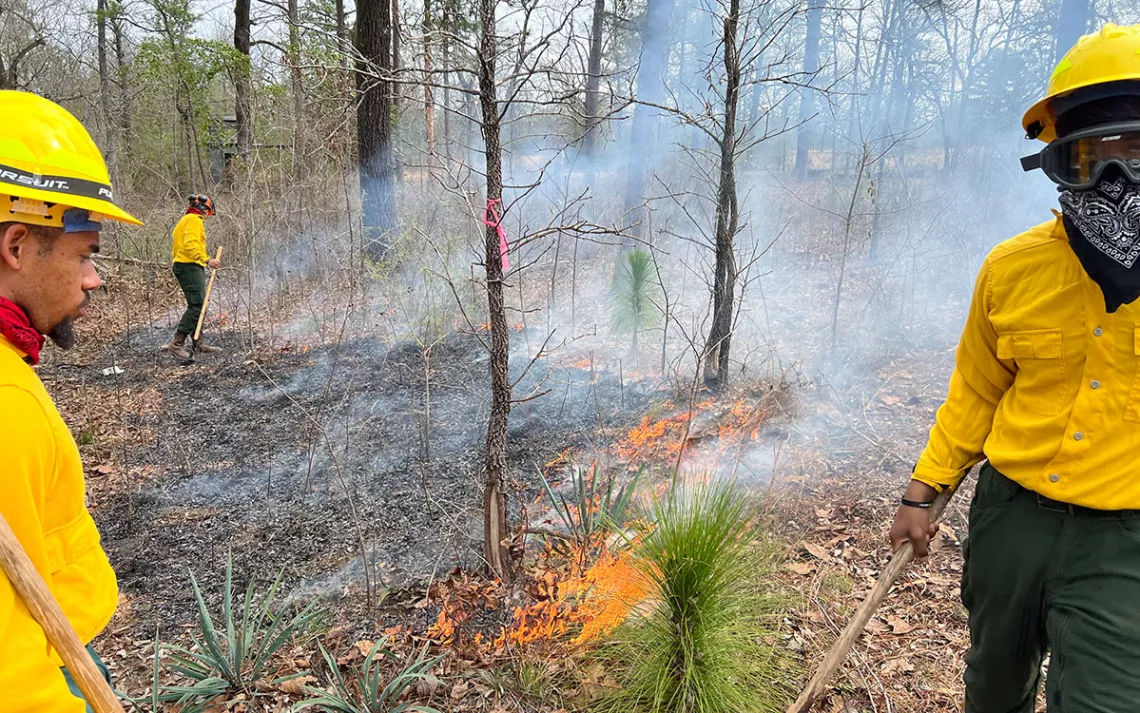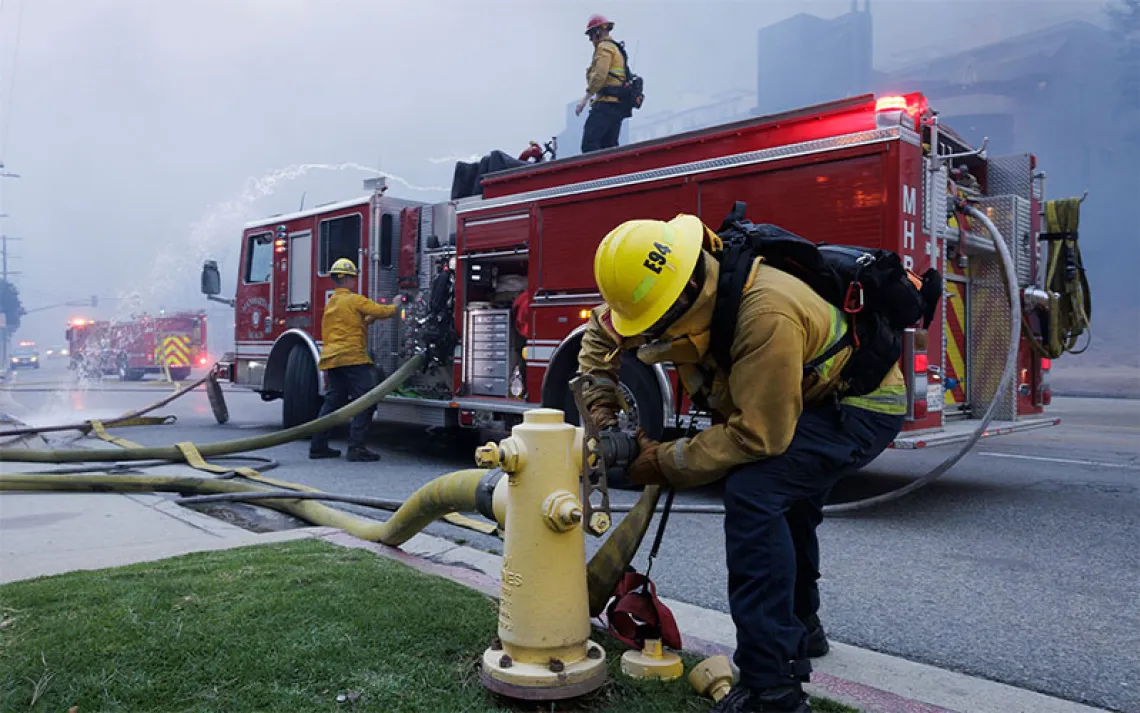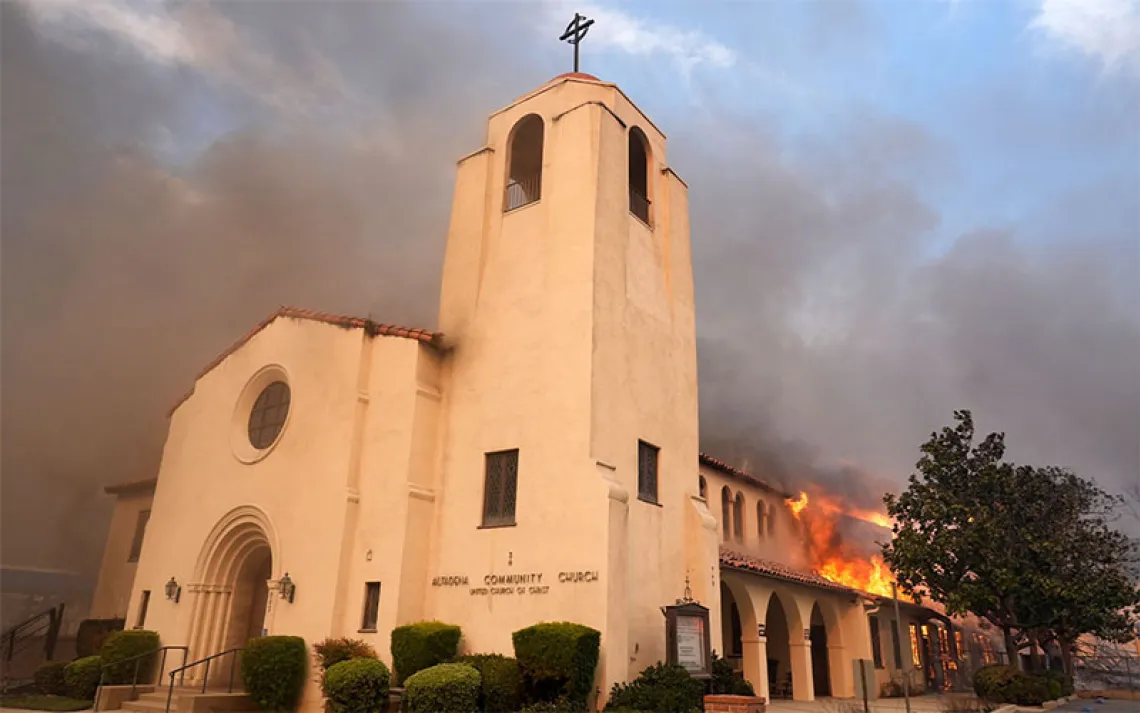Diversifying the Next Generation of Wildland Firefighters
A partnership between the US Forest Service and four HBCUs is shifting the mostly white forestry workforce

The Alabama A&M FireDawgs at a prescribed fire training in Tuskegee, Alabama. | Photo by Jeremy Whigham
When Chris Burns transferred into Alabama A&M University’s forestry department, he was immediately drawn to the school’s FireDawgs program. The first student-led wildland firefighting team at a historically Black college and university (HBCU) deploys its members to assist state and national firefighters with quelling wildfires. Now in his final year of the program, Burns is also leading prescribed burns to maintain forests near the school’s Huntsville campus.
“You get squared away with gear, get trained, and can be doing this as a profession,” he said. “As a student, who wouldn’t want to take this opportunity?”
The current forestry workforce is overwhelmingly white. At the university level, only about 11 percent of forestry students are minorities, the lowest of all natural resources disciplines. On the job, under 4 percent of the US Forest Service workforce is Black.
One of the Forest Service’s main goals in its first diversity, equity, and inclusion plan is to “achieve a workforce representative of Americans that inspires development of innovative ideas and best practices” by 2026. At the very top, Randy Moore became the service’s first Black chief in 2021. To employ a staff that’s representative of the country, the Forest Service is leaning into partnerships. It reached out to the Alabama A&M FireDawgs with a proposal: funding to create a fire training program for HBCU students, with the explicit intention of hiring students out of the cohort. In 2020, the 1890 Land Grant Institution Wildland Fire Consortium was born (the year references when many southeastern HBCUs, including the consortium schools, became land grant schools). Today, about 20 students across four such universities participate. While the FireDawgs program gives students like Burns plenty of hands-on experience, it can’t issue official fire certification. The consortium, which brings in Forest Service personnel for its training, can.
“We want to look like the Americans we serve,” said Stephanie Love, who manages the Forest Service's national diversity student programs. Love is also an Alabama A&M graduate herself and part of the FireDawgs origin story, which has legendary status on campus.
In 2002, students who were already trained as wildland firefighters responded voluntarily to a wildfire while camping in a state park. The dispatcher they called to report the fire was Love, who was a graduate student at the time. In 2010, the Alabama Forestry Commission officially recognized the group and, with the university and the national forest service, formalized the FireDawgs program to fund and train students in wildland firefighting.
Around 65 percent of the Forest Service's Black forester and firefighter new hires have come from a broader workforce diversity partnership between Love’s office and Alabama A&M, which goes back to 1992. The consortium, founded in 2020, is its newest program, teaching both wildland firefighting and prescribed fire skills at events across the participating schools, with a week-long field training in Alabama A&M’s Huntsville forest.
“The vast majority [of students] come in [to forest science] with pretty limited experience in the outdoors,” said Jeremy Whigham, an Alabama A&M forester and the FireDawgs coordinator. “We’re working like mad to get these young people ready for a career in the outdoors.”
Students leave the consortium with a 40-hour Type Two fire training certification, after they pass the final test at the end, which allows them to start a wildland firefighting career multiple rungs above entry level. Graduates of the consortium program then get placed with fire crews and foresters across the country. Love’s goal is job placement for 100 percent of students who complete the program.
The relationships students can develop with instructors from the Forest Service is one of the most important aspects, said Whigham, so that later when they’re hired “they’re not going to join a team with strangers. They know someone there, they're comfortable with them, and that’s huge.”
Before enrolling as a student at Alabama A&M, Xavier Lee had always been fascinated by fire but had little experience working with it. After graduating in 2022 and participating in the consortium and FireDawgs, he joined a firefighting crew out west led by Ben McLane, one of his instructors during the consortium training.
“When I got out there he made sure I was good,” Lee said.
The crew was stationed in Washington in the Gifford Pinchot National Forest and deployed as far as Alaska to fight fires. Everything he trained for in Alabama was applicable on the job site, he said.
“Historically, as in many other areas in our nation, we have not had demographic representation in our workforce,” said McLane, who is a member of the Forest Service’s Workforce Diversity Committee. “I believe that’s a moral problem. Everyone can have a chance to do this job.”
Burns, who will graduate from Alabama A&M next spring, grew up loving the outdoors, especially spending time in the forest. As an ambassador for the National Park Trust’s HBCUs Outside program, he has taken fellow students into the woods, on fishing trips, and for a rock climbing excursion—all experiences where his group could be the only non-white cohort on the trail or the river.
This will likely be the case if he works in forestry after graduating as well.
“I have no problem going to an area that’s less diverse and me being the person to start diversity in an area,” Burns said. “I see it as an opportunity, not a hindrance.”
In June he was sworn into the first class of American Climate Corps members, and this summer is interning with the Forest Service in Georgia. In the spring, he’ll finish school with his FireDawgs experience, consortium training, and relationships forged through both.
When he graduates, he wants to join a wildland firefighting crew, “diving straight in and gaining as much experience as possible.” His plan is to log the longer, extended travel time required of that work now so that when his daughter is older, he’ll be able to shift into management and work more regular hours from an office.
“The program helps you face adversity,” he said, “Us being from an HBCU, we already face adversity as it is — it's not something we’re new to. Being part of the program, and strengthening our understanding of how we can be working together, [both] give you that boost of confidence to go out and work in places you’ve never been to.”
 The Magazine of The Sierra Club
The Magazine of The Sierra Club



